Last Updated on 28.08.2024 by hrushetskyy
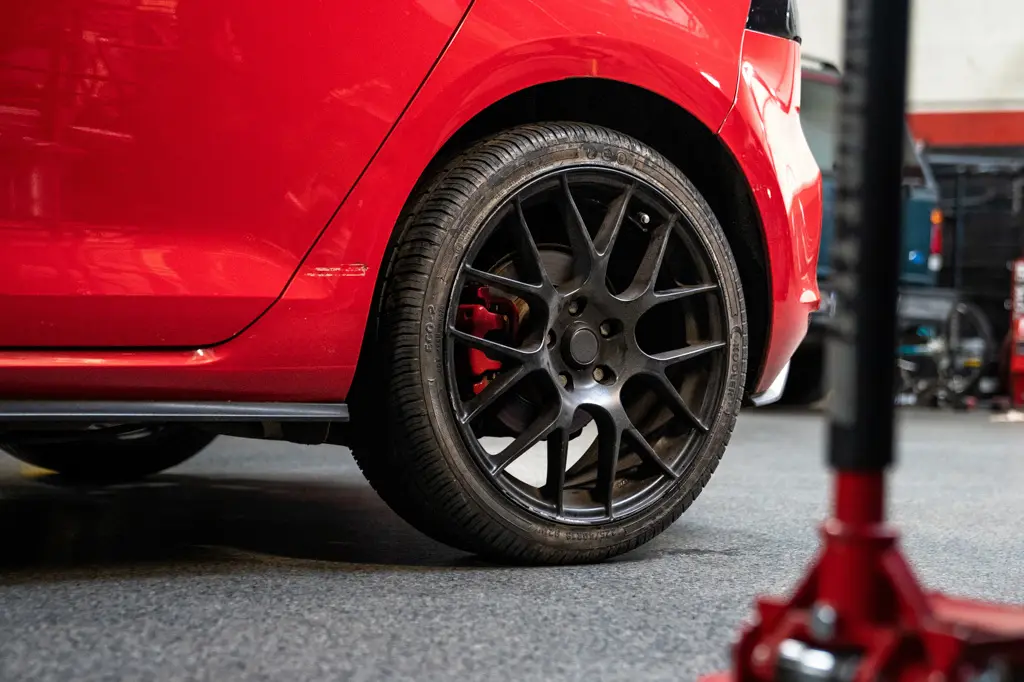
Tire sidewalls turn brown because of a reaction called tire blooming. This occurs when antiozonant chemicals in the tire’s rubber react with oxygen and UV light. While this process is natural, it can be unsightly. In this article, we’ll explore “why tire sidewalls turn brown and how to prevent it” effectively, sharing tips and insights on this common issue.
Understanding tire blooming
Tire blooming is a chemical reaction that results in the brown discoloration of your tires’ sidewalls. Oils and other substances released from the tire cause this discoloration. This phenomenon occurs due to the antiozonant compounds in the rubber, which are designed to protect the tire from the damaging effects of ozone and UV rays. If you’ve encountered tire blooming, you’re witnessing this natural process, which is not the tire itself but a reaction happening on its surface.
Tires bloom because antiozonant pushes its way to the outer edge of the rubber casing with time. As the element comes into contact with oxygen, it leaves a brown residue on the surface of the tire. Antiozonant is organic and helps tires last longer as it slows deterioration due to oxidation. This makes it possible to manufacture long-lasting, high-mileage tires that can last up to 10 years. The rubber structure is designed to allow the element to move forward to the surface, thus continuously providing the material with its benefits. As a result, the tire remains pliable and UV/oxygen-resistant for a longer time.
While mold releases or silicone-based products don’t cause tire blooming, they can exacerbate the problem by trapping antiozonants on the tire surface.
Despite not affecting tire performance, tire blooming leaves a brownish hue that many car owners find unattractive. By adopting regular maintenance and proper care, the effects of tire blooming can be mitigated, keeping your tires clean and visually appealing.
Causes of tire browning
Tires bloom due to the interaction of their compound components with UV rays. Exposure to UV light can cause the rubber in tires to break down, leading to browning. Additionally, oxygen and ozone in the atmosphere can degrade tire rubber, contributing to the brown residue that forms on the tire surface.
Organic compounds known as antiozonants are added to rubber materials to slow down deterioration caused by environmental exposure. They prevent the surface of the material from oxidizing and keep the material pliable. However, these antiozonants also react under the influence of UV light, oxygen, and heat, leading to tire browning.
While this process contributes to the production of durable, high-mileage brown tires, it also causes the tire sidewalls to turn brown over time.
What antiozonant is used in tire manufacturing to avoid tire sidewalls turning brown?
Tire manufacturers use specific chemicals, called antiozonants, to prevent tire sidewalls from turning brown. The most commonly used antiozonant in tire manufacturing is 1.3-Dimethylbutyl-N′-phenyl-p-phenylenediamine (6PPD). This compound migrates to the tire surface, where it reacts with ozone and prevents the rubber from oxidizing and cracking, thereby extending the tire’s life and maintaining its appearance.
6PPD continuously provides protection as long as it remains within the tire compound. Its migration through the rubber to the surface ensures ongoing protection against ozone exposure. In addition to 6PPD, manufacturers may use other materials like waxes to provide both short-term and long-term ozone protection, enhancing the overall durability and appearance of the tires.
The impact of mold releases on tires
Mold releases used in tire manufacture don’t cause tire sidewalls to turn brown directly. However, they contribute to the issue by keeping the antiozonant on the tire’s surface. The closer it is to the outer edge of the tire structure, the more the oxidation process will cause it to leave a brown residue.
Mold releases are non-stick lubricants applied in tire molds to help release the tires smoothly. Some of this lubricant often remains on the tire, which may contribute to blooming after just a few weeks of driving.
Silicone as a contributor to tire blooming
Tires do not bloom because of silicone-based tire dressings. Silicone is sticky, so it may allow dirt and dust to hold on to the surface of the tire as you drive, which makes tire sidewalls turn brown. The tire becomes dirty but doesn’t bloom. In this case, you can remove the color with a simple cleaning using a brush and some water. Or, remove silicone-based dressings with special degreasers and scrubbing.
How brake dust accelerates tire blooming
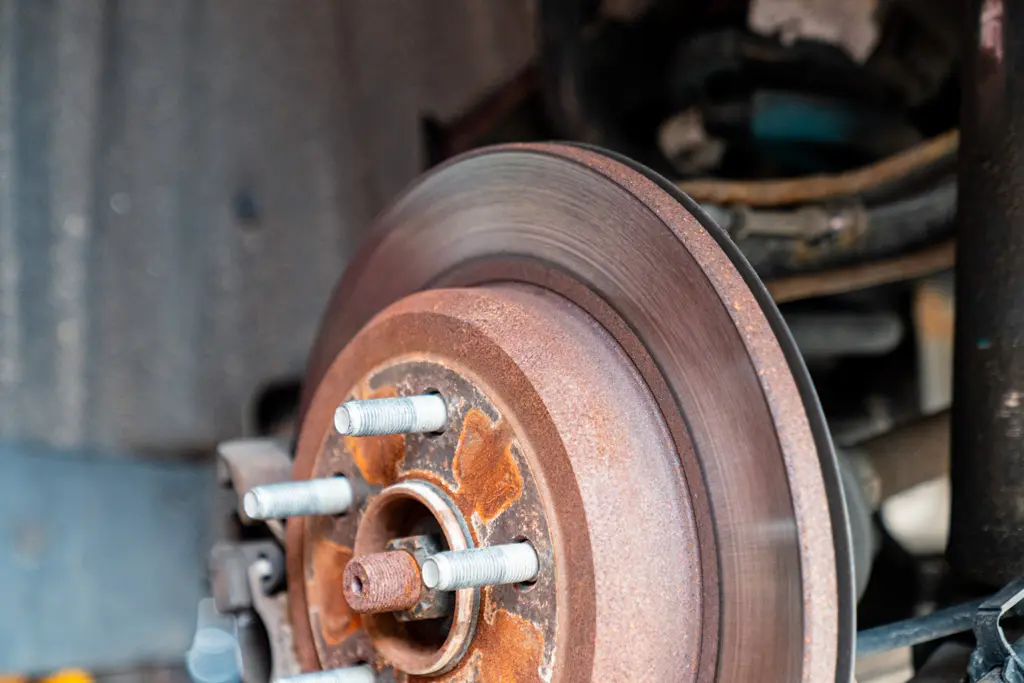
Brake dust, composed of metal and rubber particles, can cause tires to turn brown. These metallic particles can stick to the tire surface, further attracting antiozonants to the surface, where they react and cause blooming.
Brake dust acts as an abrasive, wearing down the tire surface and making it more susceptible to blooming. It can create a layer on the tire surface that traps moisture, leading to increased tire blooming. Regularly scrubbing tires to remove brake dust can help prevent this acceleration of the blooming process.
Tire sidewalls from turning brown: preventative measures
Maintaining tire sidewall color involves regular cleaning, applying quality tire dressings, and avoiding silicone-based products. Thoroughly cleaning and protecting the tires are essential steps to help prevent tire blooming. For the best results, it’s recommended to do both.
Cleaning car tires to prevent tire blooming
For regular cleaning as a preventative measure against blooming, follow these steps:
- Dry-Clean: Use a brush to remove most of the dirt and debris from the tires and rims.
- Rinse: Rinse the tires with water, preferably using a garden hose.
- Apply Cleaner: Use a special tire cleaner or make your own by adding one teaspoon of dish soap per gallon of water. Apply the cleaner and leave it for a couple of minutes or as specified in the cleaner’s manual.
- Scrub: Take a tire brush and clean every inch of the area where the tire sidewalls turn brown. Gradually move to the rest of the tire. Ensure the brush isn’t too harsh to avoid scratching the tire. Avoid brushes with steel teeth, as they may penetrate the rubber and cause air leaks.
- Rinse again: Use a pressure washer or garden hose to rinse the wheels and tires, washing off as much dirt as possible. Tire cleaners are usually environmentally friendly, so you can let them flow into the yard with the water.
- Repeat: Repeat the process if necessary.
- Dry: Dry the tires and rims with a towel.
NOTE: Make sure you don’t use aggressive tire cleaners, as they may remove the outer rubber layer. Such damage won’t affect performance, but it will make tire sidewalls turn brown even more.
Using quality tire dressings
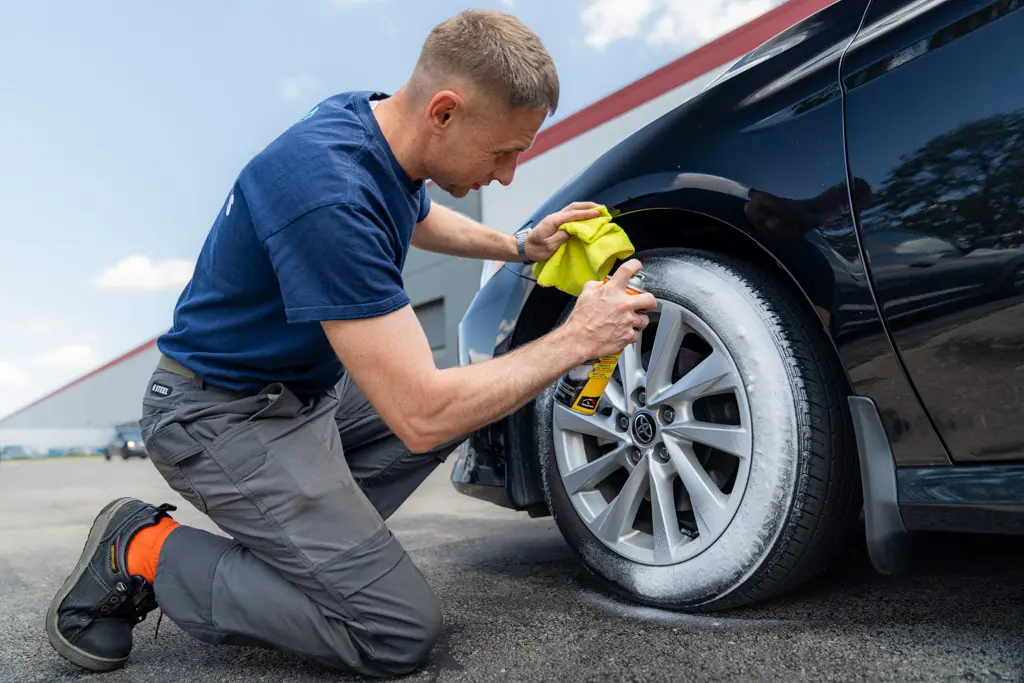
Tire dressing is the most common and popular form of protection when tire sidewalls turn brown. Quality tire dressing offers the following benefits:
- Intensifies the rubber’s black color
- Safeguards against subsequent discoloration and blooming
- Restores the black appearance
- Offers a protective layer against UV rays and dirt
- Seals and conditions the tires
Two main types of tire dressings
- Water-based
- These usually look like a milky liquid and contain a combination of natural oils and synthetic polymers. Many water-based coats also have special UV-protecting elements and don’t cause rubber degradation over time. Additionally, this type is the most environmentally friendly and economical.
- Solvent-based
- These usually have silicone as their base and look like a sticky, clear liquid. They are more concentrated and create a glossy film on the tire when applied. However, solvent-based dressings may contain petroleum distillate solvents that can cause premature rubber deterioration.
Applying a quality water-based dressing like VRT or a dressing low in silicone content like Adam’s Tire Shine can slow down the reappearance of tire blooming. These products create a protective barrier that keeps antiozonants from reacting with environmental elements, thereby maintaining the tire’s appearance.
Dressings fill the tiny pores on the tire surface, enhancing the tire’s color depth. There are three types of finishes that can be achieved: glossy, satin, and matte. However, the effect is not long-lasting, and tire sidewalls may turn brown again over time. This is due to the liquid ingredients and the thin layer of application. If the tires are perfectly clean, you can apply two or more layers for a more long-lasting effect.
Avoid silicone-based products!
Avoid silicone-based products, as they can draw dirt and potentially degrade the tire’s appearance by accumulating grime. While silicone-based products do not cause tire blooming, they can lead to a dirty appearance due to the silicone holding dirt and debris on the tire’s surface.
Tips on tire cleaning
- Follow the instructions
Check if the cleaner is for wet or dry tires, if it can be reapplied, etc. Also, note the expiration date, as most tire cleaners are usable for only 1-2 months.
- Clean the tires and rims first
Clean the tires first when washing your car. Tires are usually the dirtiest part of your vehicle, so cleaning them first prevents splashing dirt onto a clean car later.
- Use a separate water bucket
If using a bucket instead of a hose, ensure you have a separate bucket for your tires. Also, use separate sponges or thoroughly clean them before using them on your car. Debris and brake dust from the tires may scratch the paint, and materials used for your car may be too dirty for the tires, causing tire sidewalls to turn brown.
- Avoid splashing cleaner on the rim and car body
Some cleaners can damage the paint or make it dull. Unless the instructions indicate it’s safe, cover the rim and surrounding car body when spraying the substance on the tires.
Pros and cons of tire dressings
Pros:
- They are one of the best solutions for preventing tire sidewalls from turning brown and for preventing excess oxidation, cracking, and fading.
- Most dressings lubricate the rubber, extending its lifespan. That’s why they are also called rejuvenators.
- Water-based dressings are biodegradable, so they are environmentally friendly.
- Many products come in convenient sprays that are easy to apply.
Cons:
- Solvent-based dressings may get onto the car body when you drive. If they contain petroleum distillate, they may damage the paint.
- Using sprays and aerosols may damage the brakes and rims, as it’s harder to control where small amounts of the substance go.
- In the long run, some coatings may damage the tire, promoting cracking.
Tire wax
Tire waxes lubricate the tire and fill the pores with essential components. Although their composition is different, tire waxes act similarly to shoe waxes. However, tire wax requires more time to apply because the tire must be cleaned and degreased beforehand. After applying the wax, you need to wait and then buff it off.
Waxes are easier to remove if needed, and their effect lasts longer. If applied to dirty tires, the color will last only a few days, causing the tire sidewalls to turn brown again soon. However, if you properly prepare the tire and follow the instructions, the effect will last for weeks.
Tire sealant
Sealants are the least common type of tire coating, but they are becoming increasingly popular due to their long-lasting effect. When applied according to the instructions, sealants can last up to a year, while otherwise, the effect may only last a few weeks.
A sealant is a mix of polymers designed to cover the tire with a special coat. The substance binds tightly to the tire and becomes a flexible protector for months. The main drawbacks are the cost and the significant amount of work and time required to apply it properly.
Deep cleaning techniques
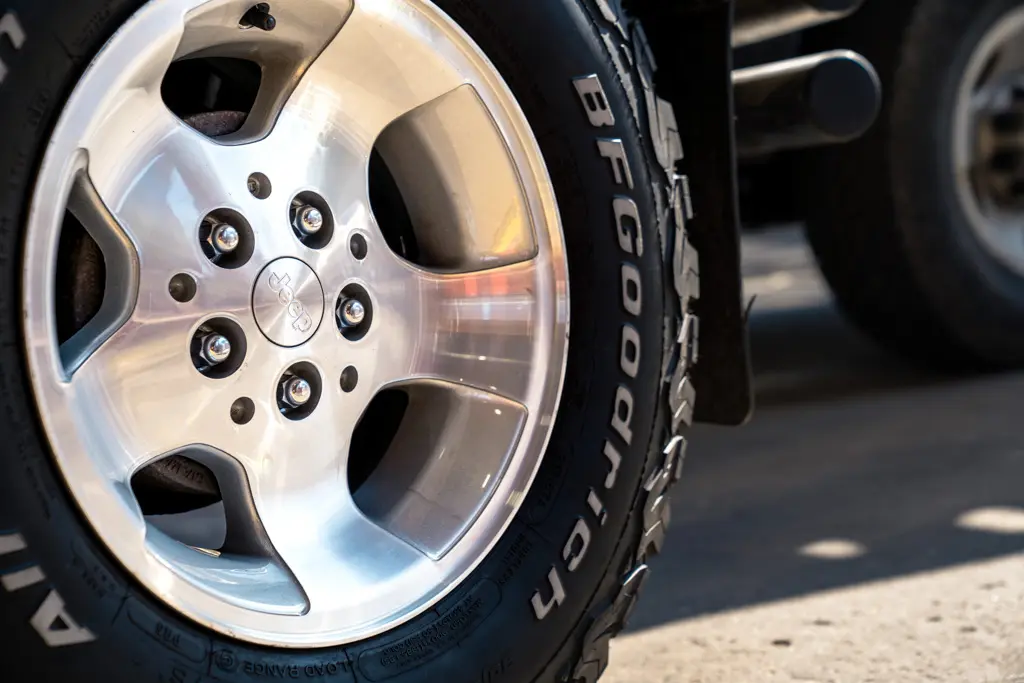
Deep cleaning techniques are indispensable for keeping tires clean. Here are some steps to follow:
- Apply a tire cleaner and allow it to sit for a few minutes before scrubbing. This will enhance the deep cleaning process.
- Regularly clean your tires with leftover car wash soap and a tire cleaning brush. This is usually sufficient for regular maintenance.
- If your tires are very dirty or badly browned, consider using a rubber cleaning product for a more effective cleaning.
By following these steps, you can keep your tires looking clean and well-maintained.
Using a heavy-duty degreaser like Adam’s Tire & Rubber Cleaner can help break down the brown residues caused by blooming. Special degreasers and scrubbing are required to remove silicone-based dressings effectively. Using a medium brush to clean tires and rims can remove most of the dirt and debris.
Applying non-stick lubricants
The application of non-stick lubricants can form a barrier on the tire surface, preventing new blooming. Lubricants should be applied evenly across the tire to ensure comprehensive coverage.
Final touch: tire shine application
The final step in tire maintenance involves applying tire shine with a foam applicator for uniform distribution and minimal streaking. This not only enhances the tire’s appearance but also provides a protective layer against environmental elements.
Ensure to apply the tire shine evenly and allow it to dry completely for the best results.
Protecting car tires
After cleaning, it’s time to protect your tires. This can be done in several ways:
- Using common tire dressing:
- Water-based
- Solvent-based
- Using tire wax
- Using tire sealant
Note: These methods will also help if you still see a bloom or a white film after thorough cleaning.
The importance of regular tire cleaning and dressing
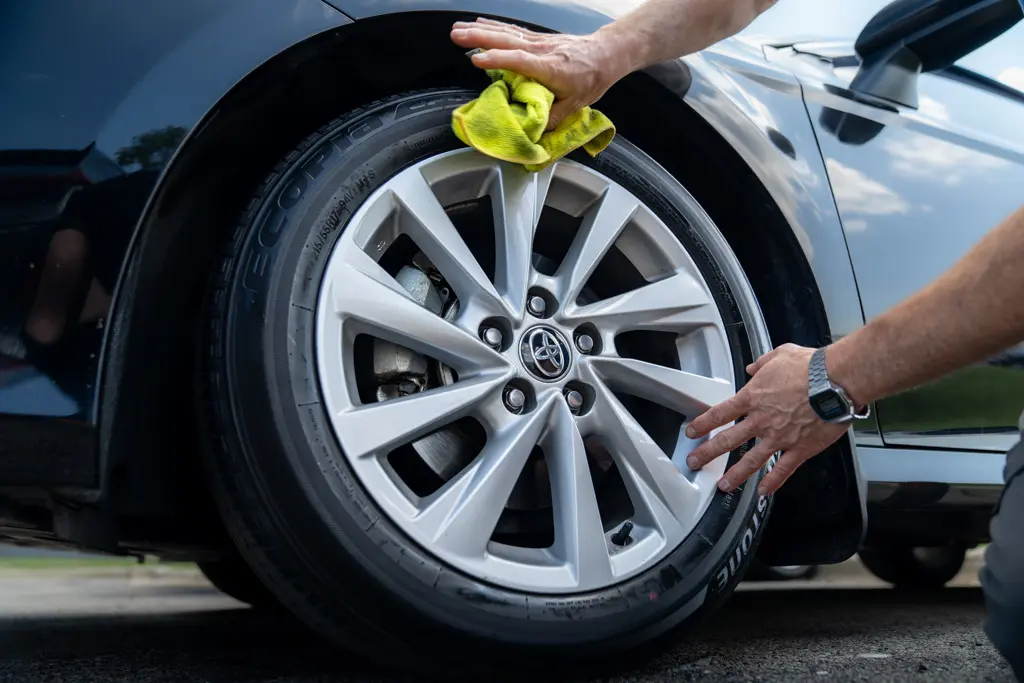
Tire sidewalls will continuously turn brown, so it’s not possible to eliminate this issue entirely. However, regular cleaning and protection will prevent tire blooming or temporarily remove it if it has already occurred. Perform these procedures once a week (unless the tire protection instructions suggest otherwise) to achieve the best results.
Every tire has its own predisposition to blooming, which depends on factors such as the rubber blend, tire type, driving conditions, and driving habits. Regular cleaning and protection will help prolong the life of your tires and reduce blooming.
Myths about tire blooming
Several misconceptions about tire blooming need to be debunked. Understanding these myths will help you take better care of your tires and avoid unnecessary worries.
For instance, a common belief is that only old tires experience tire blooming and that all tire dressings lead to blooming.
Myth #1 – Only old tires bloom
It’s a common misconception that only old tires bloom. In reality, even new tires can experience blooming due to the antiozonant compounds in the rubber. Browning of tire sidewalls is due to antiozonants in the tire’s rubber reacting with the environment, and this can happen regardless of the tire’s age.
The presence and reaction of antiozonants in the rubber, not the age of the tires, cause blooming. Therefore, it’s essential to understand that tire blooming can occur in both new and old tires.
Myth #2 – All tire dressings cause blooming
Another common misconception is that tire dressings lead to blooming. On the contrary, tire dressings don’t cause blooming; they can actually prevent it when applied regularly by protecting the tire from UV rays and harsh environmental conditions. Silicone-based tire dressings might attract dirt and dust, leading to browning on the tire’s surface, but they do not cause tire blooming.
Frequently Asked Questions
What is tire blooming?
Tire blooming is a chemical reaction in which the sidewalls of tires turn brown due to the rubber’s antiozonant compounds reacting with oxygen and environmental elements.
Do tire dressings cause tire blooming?
No, tire dressings do not cause tire blooming. Quality tire dressings can actually prevent blooming by protecting the tires from UV rays and environmental damage.
Can new tires experience tire blooming?
Yes, new tires can experience blooming due to the reaction of antiozonants in the rubber with environmental elements. Be mindful of this regardless of the tire’s age.
How can I prevent my tires from turning brown?
To prevent your tires from turning brown, regularly clean them, use water-based tire dressings, and avoid silicone-based products. This will help maintain their appearance and condition.
Share the Knowledge
